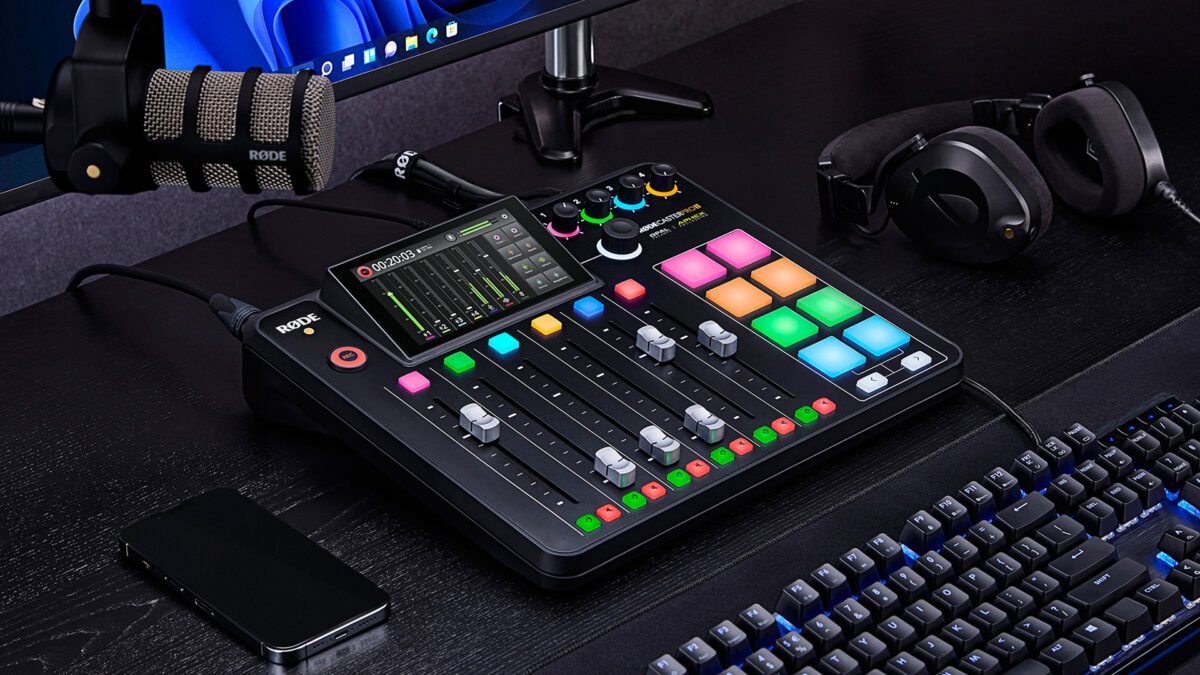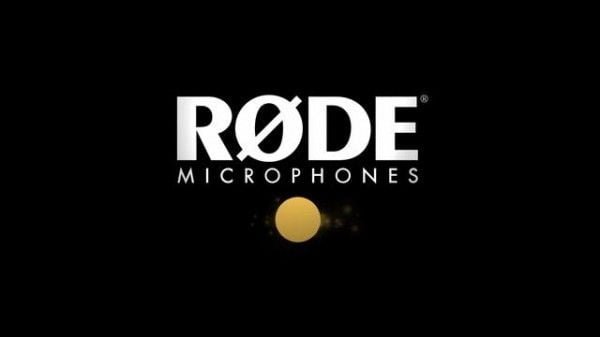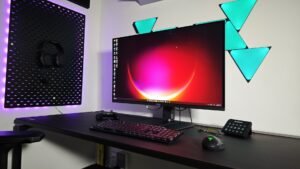When the Rodecaster Pro came out in 2018, it was very unique in the content creator space. It was revolutionary for the podcaster, creating a complete recording studio in a single device. For streamers, it was a viable device, but simultaneously too much and not enough. People didn’t need a device with four mic inputs to stream, and the Rodecaster was missing some key software features that were offered by a more streamlined device introduced at the same time.
Since then, the basic needs of the podcaster haven’t changed a whole heck of a lot, but the needs of a streamer have evolved greatly. Some stream in multiple areas, but nearly everyone has been spoiled with the software solutions of a number of USB microphones and audio interfaces. For an heir apparent to the Rodecaster Pro to keep up, it would have to make some big changes.
Well they’ve done it with the Rodecaster Pro II and, frankly, they’ve done more than just keep up.

Only the second generation of this device, the Rodecaster Pro II may look familiar, but it has made some huge upgrades that put it in line with any other audio interface on the market, but with more control, endless features, a streamlined body and the ability to bring your own XLR microphones to the party.
Starting with the back of the device, you have four combo XLR/Line Inputs from Neutrik that allow you to plug in your XLR Mic, Instruments or other Line devices. It also has ¼ inch (6.35 mm) left/right monitor out jacks, four ¼ inch headphone jacks, two USB-C ports, an Ethernet port for wired internet, a microSD card slot for on-board recording and saving your profiles, another USB-C Port for power, and the power button.
“…the Rodecaster Pro II may look familiar, but it has made some huge upgrades that put it in line with any other audio interface on the market…”
About the headphone jacks… It is important to know that, currently, there are limitations to which headphone positions can hear what. This is neither a malfunction nor an accident. The first headphone position has the ability to hear a lot more of the audio than the other three positions. If content is muted, but listen is also selected, the first position (called the host) can still hear it, so they can confirm levels before putting it on air. There is also a setting to allow the host to hear the audio at line-level, before the fader.
The first Rodecaster Pro had an additional headphone jack at the front of the device which acted as a producer’s position and could also hear everything that the host position could hear. Now, you have only one position. If I were to make a suggestion to the people at Rode, I’d have a setting that could assign the host access to any and all headphone positions.
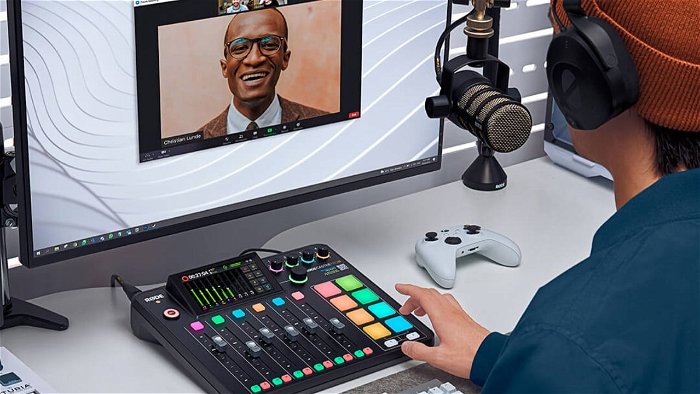
The dual USB-C ports allow for two devices to be connected to play audio on the Rodecaster Pro II or to connect them to each other. It is the first audio interface that doesn’t need any fancy tricks to connect to a two-PC streaming system. Audio can pass through from one computer to the other through the Rodecaster via this setup.
On the surface of the Rodecaster Pro II, you have a beautifully updated LED display that is tilted up a bit for better viewing. It is also a touchscreen with haptic feedback, six faders with mute and solo buttons along the bottom and menu buttons along the top, an 8 button, 8 bank sound pad with page buttons to navigate, a record button for recording to the device, volume controls for the headphones, and what I choose to call the magic knob that controls a number of different functions in the settings, but also controls three virtual sources.This gives you physical control of nine total sources when you include the faders.
The device comes with Revolution preamps and legendary Aphex processing, including their aural exciter and big bottom and a number of other on-board processing like EQ, noise gate, compressor, high pass filter, de-esser and so much more. The processing happening on the Rodecaster Pro II means that you aren’t using resources from your PC to do it, saving it for your broadcast.
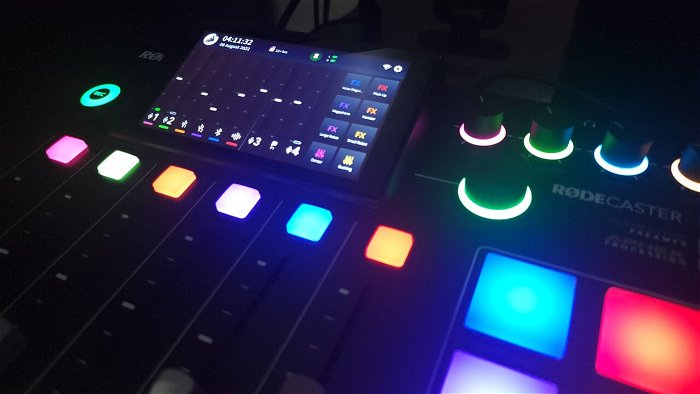
Also available is the ability to set presets for virtually every Rode microphone that they offer, but also for some of their competitors, the Electro-Voice RE20 and the famous Shure SM7B. I have a great deal of respect for this move because they refuse to let the fact that you may not own their microphones get in the way of having the best possible sound coming through their interface. Phantom power can also be turned on for any condenser mics that you happen to plug in.
Recording on the Rodecaster Pro II is as easy as hitting the record button. Settings can be changed to make the second press of the button a pause rather than a stop, so you don’t have to stitch multiple files together if you take a break during your recording session.
“Also available is the ability to set presets for virtually every Rode microphone that they offer, but also for some of their competitors, the Electro-Voice RE20 and the famous Shure SM7B.”
Customizability has been the name of the game for this new generation Rodecaster. Faders are not locked, in that you can assign any of the nine sources to any of the faders, be they physical or virtual. Do you only use two mics typically? Move the other two mics onto the virtual faders in favour of more useful sources. Even the colour coding can be changed for any fader or even headphone controls via the settings.
You are able to set multiple profiles, labelled as shows, that will save the setup of the Rodecaster Pro II, including all presets, fader and routing assignments and so much more. To save a show, you just need to export it, which will save to the on-board memory and can be imported at any time from that location.
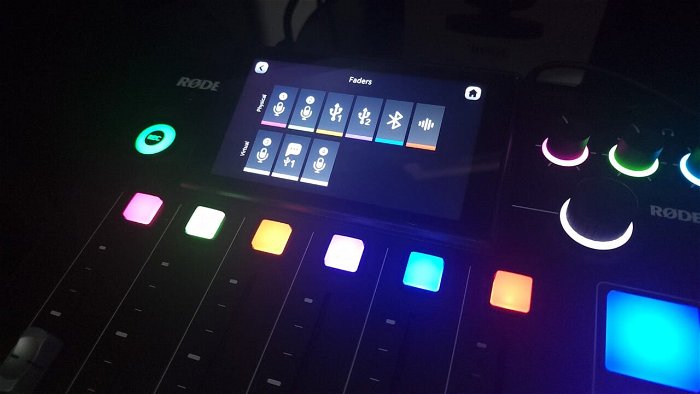
The sound pad is more than just a mere sound pad this time around. Yes, every button can be assigned as a sound either by introducing sounds via the software or recording it directly onto the button. Sounds can even be trimmed or set to fade in/out on the touch screen. Each sound can be set to toggle/hold (meaning it can be turned on and off or play as long as the button is held down), loop (meaning it can start over from the beginning) and replay/continue (meaning it will either start from the beginning when pressed again or continue where it left off).
In addition to the sounds, the buttons can be effects. It can be set as a sensor button with a bevy of options including the classic beep, trash talk which mutes the output to your chat, so people can talk on the mic without chat hearing and more. Other effects are voice effects that can be customized as you please but also include presets to sound like a robot, a monster, change pitch and more.
“Choosing to nitpick, the Rodecaster Pro II’s size is still a challenge for some streamers’ desks.”
What’s more, the sound pad is capable of multidirectional MIDI controls, so any device that has MIDI control capability can be controlled via one of these buttons. If you use a MIDI plugin on OBS, you can turn your sound pad into a stream deck very easily.
Another big improvement of the Rodecaster Pro II’s sound pad functionality is that you can see the labels of the buttons on the touch screen, so you know what each button does at a glance. As an early adopter of the OG Rodecaster, I remember unboxing and getting a large whiteboard in the box where I could write down what I have assigned to each button. This upgrade makes that white board which, at the time, was quaint at best, seem very archaic now by comparison.

Choosing to nitpick, the Rodecaster Pro II’s size is still a challenge for some streamers’ desks. It takes up more landscape than every other piece of gear on my desk combined (literally. I checked). In fairness, though, it isn’t an inch bigger than it needs to be. The addition of the virtual faders was a big help in shrinking this device, but it’s still a big boy. The other issue is that, for all of its customizable audio features, the lack of a true submix seems like a bit of an oversight.
To Rode’s credit, though, they always tend to come through with firmware updates that fix a lot of early issues. For example, their first major update to the Rodecaster Pro II included a routing table, allowing to remove sources from going to the stereo output, a huge (and necessary in my opinion) feature of any audio interface. The fact that submixes are missing now does not mean that they will always be missing, but it is something I would like to see. In the meantime, you can cheat a little by muting/listening to certain sources and using pre-fader options for sources when needed. It’s not a submix per se, but it’s something.
The Rodecaster Pro II comes in at a pricey $699 USD. This seems like a lot (and it is), but is perfectly in line with the value it provides. Its upgrades from the original version are giant leaps, but they also listened to content creators and made the improvements that everyone was looking for. This is a full recording studio, a top of the line stream interface and comes from one of the premiere names in audio. I know I am an advocate of not spending more than you need to for content creation, particularly if you are someone who doesn’t make money on their content, but the Rodecaster is worth every penny if you are a creator of multiple types of content and need the extra inputs for multiple-user broadcasts.
